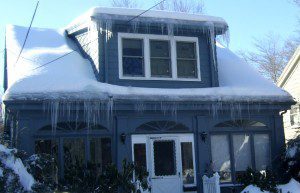Frozen downspouts
 This week’s number one problem has been frozen downspouts. Weather conditions have been perfect for freezing downspouts. Once the route down is frozen, the gutters will drip over and form those pretty icicles you’ve been seeing. I have been seeing the icicles, and frozen downspouts, all over town.
This week’s number one problem has been frozen downspouts. Weather conditions have been perfect for freezing downspouts. Once the route down is frozen, the gutters will drip over and form those pretty icicles you’ve been seeing. I have been seeing the icicles, and frozen downspouts, all over town.
Here is a glossary of terms about gutters and downspouts.
What can you do about this?
Prevention: Downspouts freeze quickly if the water flow is stopped somewhere along the way.
 In the recent storm, the heavy wet snow was enough to block water flow at the bottom, if the ends weren’t shoveled clear. Because of the thawing and refreezing this week, downspouts also froze up at the elbows. Prevention involves clearing the ends of the downspouts and also keeping an eye on the elbow joints.
In the recent storm, the heavy wet snow was enough to block water flow at the bottom, if the ends weren’t shoveled clear. Because of the thawing and refreezing this week, downspouts also froze up at the elbows. Prevention involves clearing the ends of the downspouts and also keeping an eye on the elbow joints.
Downspouts collected ice inside, where the downspouts were dented or bent. Long-term prevention involves checking for bends and dings in the downspouts before winter sets in.
Action: On line advice about frozen downspouts varies. Some say just leave it alone. Others recommend taking ice-melt to the gutters (see below.) A few say heat the gutters to clear them. One recommends whacking the gutter (from an upstairs window) with a baseball bat. Yet another recommends running electrical heat tape to prevent melting.
What to look for to prevent a big problem?
The main reason that you don’t want your gutters icing up is two-fold. The worst thing that can happen is for the melting ice to find its way into your house. The second worst thing that can happen is that the ice in the backed-up gutter gets heavy enough to tear the gutter off the house.
Prevention: To prevent water in your house, your roof should be installed with a sheet of rubber under it. This way, if water collects on the edge of the roof, it won’t find its way through the waterproofing. The second prevention measure is to keep your roof cold. This means insulating and ventilating your roof surface. (This is also good for lowering your heating bills.) A warm roof allows snow to melt at the bottom edge, then refreeze overnight. Then, the subsequent melting the next day increases the build-up of ice that will melt the next day, and so on. The more melting water, the more weight and pressure; these are conditions that favor water finding its easiest route down is through the wood behind your gutters. The third preventative measure is to make sure your gutters are draining well before the winter sets in. Most gutters collect leaves and debris that can impede to flow enough to allow freezing, even if the downspouts are clear. Clear and check the flow in your gutters sometime in the fall, after the leaves have fallen and before the cold sets in.
 Action: If you see awesome quantities of ice collecting in your gutters and your downspouts are frozen, you may want to take evasive action. The tried and true method is to fill a stocking with ice melt and put it in the gutter. If this is a chronic problem that happens every year, using an ice rake to clear the snow near the bottom of the roof may be an option (depending on how high your roof is.)
Action: If you see awesome quantities of ice collecting in your gutters and your downspouts are frozen, you may want to take evasive action. The tried and true method is to fill a stocking with ice melt and put it in the gutter. If this is a chronic problem that happens every year, using an ice rake to clear the snow near the bottom of the roof may be an option (depending on how high your roof is.)
 The last-ditch and most expensive and inefficient method is to install heat tape to melt the snow and prevent the refreezing.
The last-ditch and most expensive and inefficient method is to install heat tape to melt the snow and prevent the refreezing.